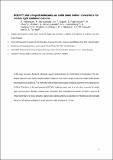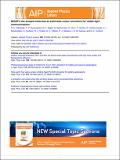Files in this item
BODIPY star-shaped molecules as solid state colour converters for visible light communications
Item metadata
| dc.contributor.author | Vithanage, Chiranthika Dimali Amarasinghe | |
| dc.contributor.author | Manousiadis, Pavlos | |
| dc.contributor.author | Sajjad, Muhammad Tariq | |
| dc.contributor.author | Rajbhandari, Sujan | |
| dc.contributor.author | Chun, Hyunchae | |
| dc.contributor.author | Orofino, Clara | |
| dc.contributor.author | Cortizo-Lacalle, Diego | |
| dc.contributor.author | Kanibolotsky, Alexander | |
| dc.contributor.author | Faulkner, Grahame | |
| dc.contributor.author | Findlay, Neil | |
| dc.contributor.author | O'Brien, Dominic | |
| dc.contributor.author | Skabara, Peter | |
| dc.contributor.author | Samuel, Ifor David William | |
| dc.contributor.author | Turnbull, Graham Alexander | |
| dc.date.accessioned | 2016-06-01T14:30:05Z | |
| dc.date.available | 2016-06-01T14:30:05Z | |
| dc.date.issued | 2016-07-06 | |
| dc.identifier | 243134394 | |
| dc.identifier | 9e41784b-c9a0-49b2-8960-bf60eff08ea9 | |
| dc.identifier | 84978427600 | |
| dc.identifier | 000379587000033 | |
| dc.identifier.citation | Vithanage , C D A , Manousiadis , P , Sajjad , M T , Rajbhandari , S , Chun , H , Orofino , C , Cortizo-Lacalle , D , Kanibolotsky , A , Faulkner , G , Findlay , N , O'Brien , D , Skabara , P , Samuel , I D W & Turnbull , G A 2016 , ' BODIPY star-shaped molecules as solid state colour converters for visible light communications ' , Applied Physics Letters , vol. 109 , no. 1 , 013302 . https://doi.org/10.1063/1.4953789 | en |
| dc.identifier.issn | 0003-6951 | |
| dc.identifier.other | ORCID: /0000-0002-2132-7091/work/31037445 | |
| dc.identifier.other | ORCID: /0000-0001-8678-9126/work/47136522 | |
| dc.identifier.other | ORCID: /0000-0001-6457-3236/work/60427399 | |
| dc.identifier.uri | https://hdl.handle.net/10023/8910 | |
| dc.description | We thank EPSRC for financial support from the UP-VLC Programme Grant (EP/K00042X/1). I.D.W.S. and P.J.S. are Royal Society Wolfson Research Merit Award holders. The research data supporting this publication can be accessed at http://dx.doi.org/10.17630/20163d03-6cc2-43b6-915c-d271f5220454. | en |
| dc.description.abstract | In this paper we study a family of solid-state, organic semiconductors for visible light communications. The star-shaped molecules have a boron-dipyrromethene (BODIPY) core with a range of side arm lengths which control the photophysical properties. The molecules emit red light with photoluminescence quantum yields ranging from 22 - 56 %. Thin films of the most promising BODIPY molecules were used as a red colour converter for visible light communications. The film enabled colour conversion with a modulation bandwidth of 73 MHz, which is 16 times higher than of a typical phosphor used in LED lighting systems. A data rate of 370 Mbit/s was demonstrated using On-Off keying modulation in a free space link with a distance of ~15 cm. | |
| dc.format.extent | 861713 | |
| dc.format.extent | 941711 | |
| dc.language.iso | eng | |
| dc.relation.ispartof | Applied Physics Letters | en |
| dc.subject | QB Astronomy | en |
| dc.subject | QC Physics | en |
| dc.subject | DAS | en |
| dc.subject.lcc | QB | en |
| dc.subject.lcc | QC | en |
| dc.title | BODIPY star-shaped molecules as solid state colour converters for visible light communications | en |
| dc.type | Journal article | en |
| dc.contributor.sponsor | EPSRC | en |
| dc.contributor.institution | University of St Andrews. School of Physics and Astronomy | en |
| dc.contributor.institution | University of St Andrews. Condensed Matter Physics | en |
| dc.identifier.doi | 10.1063/1.4953789 | |
| dc.description.status | Peer reviewed | en |
| dc.date.embargoedUntil | 2017-07-06 | |
| dc.identifier.grantnumber | EP/K00042X/1 | en |
This item appears in the following Collection(s)
Items in the St Andrews Research Repository are protected by copyright, with all rights reserved, unless otherwise indicated.


